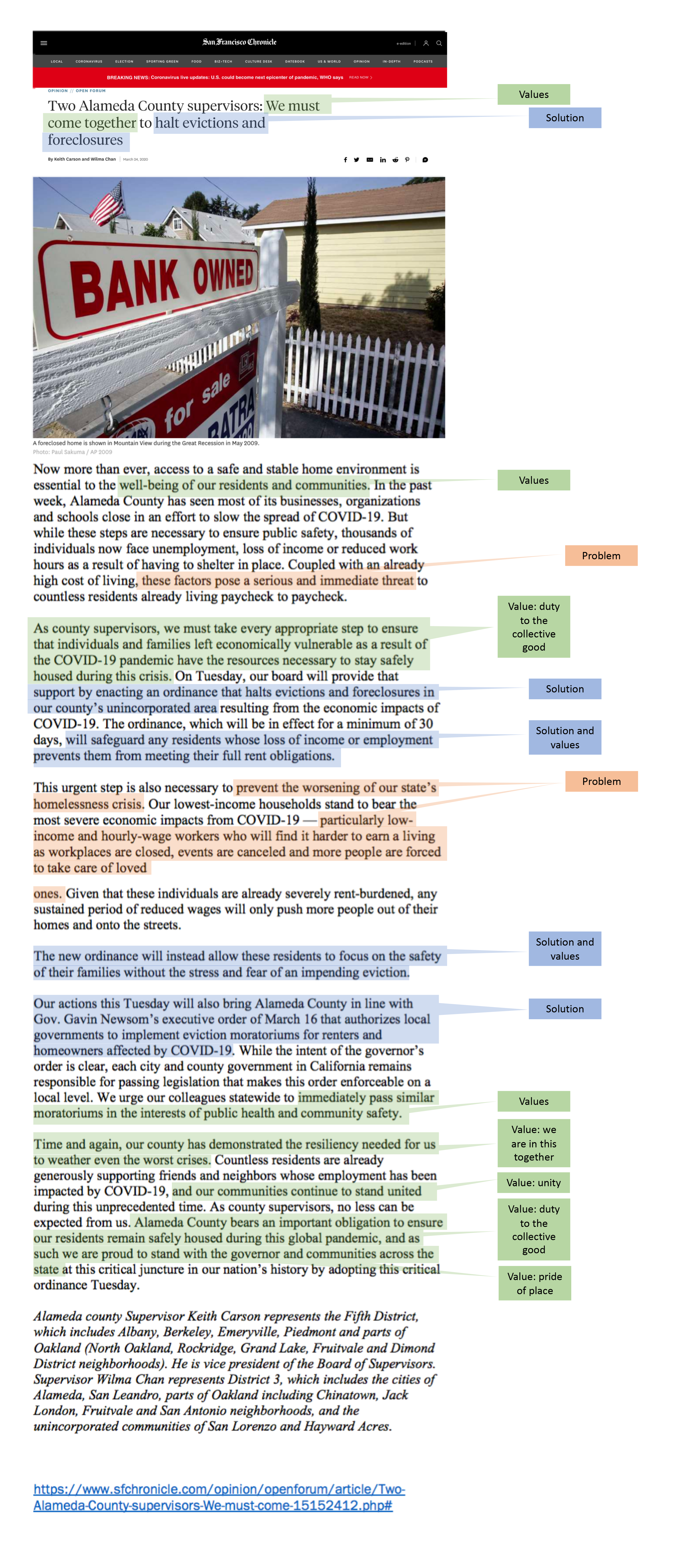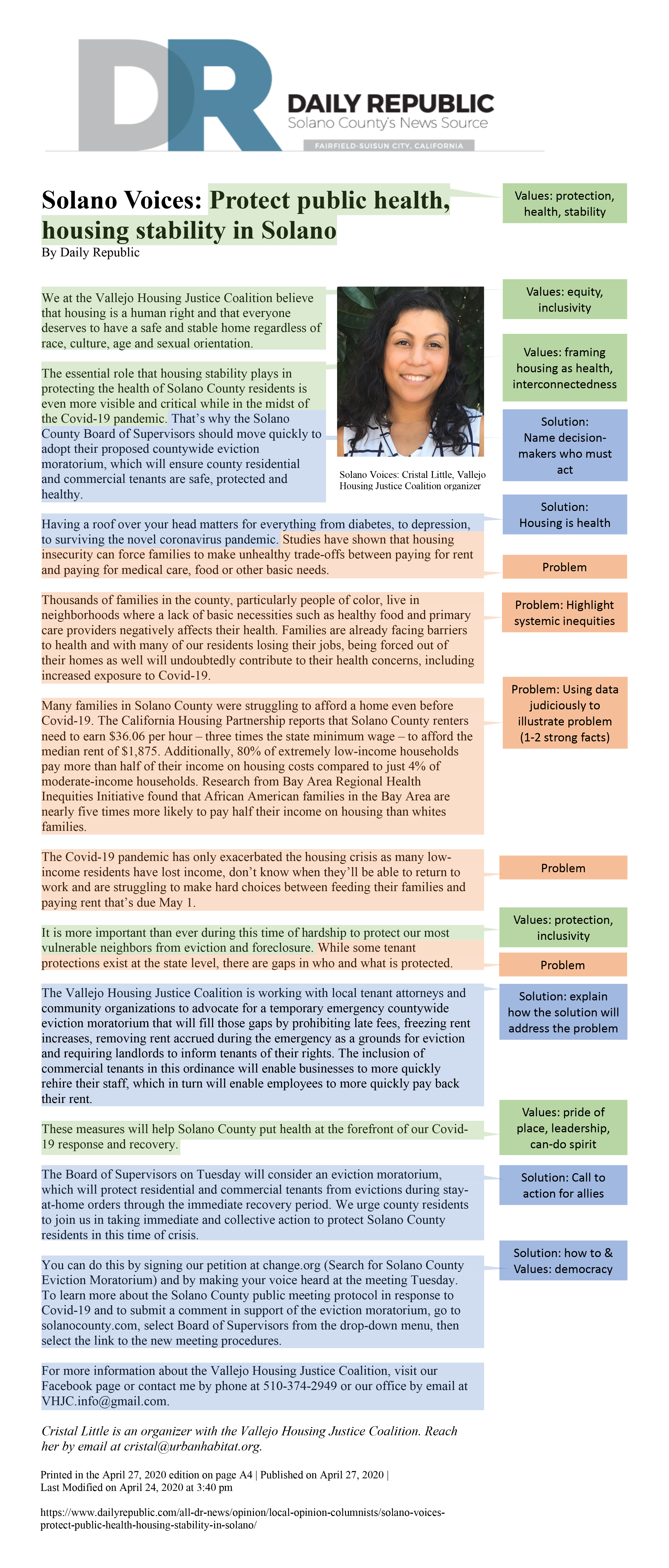Talking about health, housing, and COVID-19: Keeping equity at the forefront
Wednesday, March 25, 2020Advocates across the country have long been working to ensure that everyone has access to healthy, safe, and affordable homes. COVID-19 has brought to the forefront solutions that advocates have called for — tenant protections, stopping the sweeps of people who are unhoused, and more — as advocates push for additional, urgent ways to ensure people are sheltered during this pandemic.
For those working at the intersection of housing and health, the link is clear, yet the connection is rarely apparent in the news media. In national news coverage from March 2020, we found that fewer than 1% of stories about COVID-19 or coronavirus also mentioned housing issues like evictions, foreclosures, or homelessness. The news media play a significant role in reaching decision-makers. If the link between housing and health is not explicit in the news, decision-makers and the public may not prioritize addressing housing needs.
At this moment, we must highlight the urgent need to ensure everyone has safe shelter during the COVID-19 pandemic and emphasize that homes are a crucial foundation for a healthy society. As Tram Nguyen from the Alameda County Public Health Department put it, "We want safe and affordable housing to be increasingly seen as a social good — a human right — that market-based solutions will not necessarily provide." Just like the benefits of education extend beyond students in classrooms to the society they build or how child care helps the families who use it and boosts our economy because it allows parents to work, housing is fundamental to a society as interconnected as ours. Investments we make in housing will create benefits that extend far beyond any individual during this pandemic and beyond.
We developed this working document to support public health practitioners, community organizers, and others who are striving, amid COVID-19, to elevate equity-focused solutions in housing and health news and before policymakers. The guide is focused on shifting the narrative from safety during the pandemic to the importance of treating housing as essential to public health. As we continue to work closely with partners on housing and health, we will adapt it and provide other tools. We would love to hear about what you are learning — and what you seek guidance on — as you bring equity to the fore in your communication about housing and health.
Components of a COVID-19 message about housing and health
Whatever the circumstances are in your city or region, when you talk about housing and COVID-19, make sure your message includes values, the solution, and a quick overview of the problem, whether you are writing talking points, news releases, handouts, or other pieces.

- Lead with values. An effective message reaches people not just in their heads but in their hearts. Whatever the specific housing solution we're seeking, our messages need to explain why they matter for everyone, even those who may not always see their personal connection. The values part of the message expresses how we are connected to one another. Our values — like unity, dignity, and justice — are what motivate us, far beyond facts or figures. Use the word "our" to convey interconnection and illustrate that we are in this together with our neighbors and our community. Express your values to build a vision of where we want to go together that includes what housing should look like during this urgent moment and in our future.
- State the problem clearly. We have a problem when people don't have shelter; this is easy to illustrate in the context of COVID-19. Our message can move from a narrow definition of the problem like the spread of coronavirus (portrait) to a broader definition that focuses on why all people and communities need safe, secure, and affordable homes (landscape). The definition of the problem should lead logically to the specific system change or policy we are seeking in the moment.
- Name a specific solution. Clear solutions help people avoid the feeling that the problem is so big that nothing can be done. Housing advocates are proposing solutions that will address the urgent needs around COVID-19 and that support the long-term health of our communities. These include moratoriums on evictions and foreclosures, banning rent increases, finding immediate and then permanent shelter for people who are unhoused, and ensuring banks and credit card companies suspend fees, foreclosures, and payments, including mortgages, for residents and small businesses. Policies will differ by jurisdiction and audience; in your message, include the solution that is your current priority. People are more likely to believe change is possible if they see tangible examples, so be concrete about the solution and direct about demanding who should do what. This level of specificity can help people understand that our housing problems are the result of policy decisions made by people and can be changed to shape the community we want to create.
Tips for developing messages about housing in the context of COVID-19
- Bring racial equity to the forefront. The housing solutions we need for COVID-19 cannot be separated from the racial inequities embedded in housing policy. Research shows that we can talk about how race and class impact us — and that our messages do better when we express our unity and name how race is being used to divide us. The discussion around COVID-19 has prompted people from all walks of life to say, "We are in this together"; we can connect that core value to what we want to say about housing.
- Be wary of portrait frames. Often reporters, and other storytellers, will want to focus on the personal aspect of the story and the impact of COVID-19 on individuals. These are important stories, but they sometimes do not go far enough if they keep the solutions focused on individuals. And they can do damage when they create an "us versus them" narrative. Language like "ticking timebombs," to describe what might happen if an outbreak occurs in an area where many people are unhoused, equates encampments with disease and fear. Only use portrait frames when it is clear the problem is the system, not the people; doing so also helps us avoid otherizing language.
- Instead, bring the landscape into view… Of course, stories do need characters: When you tell personal stories, tie them to their context — a landscape that can bring the environment surrounding those characters into the picture. For example, you could talk about the actions tenants and their supporters are taking to create systems that are better for us all. Systems are the link between the problem and the solution. We have problems now because we have created systems that deny people basic access to health care, affordable homes, and employment protections; COVID-19 has vividly surfaced the limits and dangers of our failing systems.
- …but be strategic. Our messages should make the landscape around housing easier to see, from the history of how the problem got this way to the communities, agencies, and organizations that can be enlisted to repair it, as well as the vision of where we can go together. In a quick sound bite to a reporter, you won't be able to include all of the landscape, so select one thing that is most important to include at this moment for the specific solution you seek. For example, if you are seeking eviction moratoriums you could mention that local and state governments can and must act. With that statement you are bringing the landscape of political actors into view. Or if you are seeking to ensure that people who are unhoused get immediate and then permanent homes, then you could highlight the empty apartments and public lands that could be converted to housing. That statement helps people see that the solutions are within reach.
Overall tips for effective communication
Speak plainly. No matter who your audience is, avoid jargon and "insider" language. That can be challenging, since sometimes we may not even recognize our words are jargon. Have someone outside your field and from your target audience review your message to be sure what you are saying makes sense to them. If you need to use terms your audience may be unfamiliar with, define them.
Use active language. The passive voice obscures who is taking action, whether it's our organization, coalition, community, or policymakers. For example, instead of saying "people are unhoused" we can say "policymakers have made decisions that have made housing inaccessible for many families in our community." Use language that clarifies who has the power to make changes that will put the housing solutions in place.
Acknowledge people's discomfort and fear. Because COVID-19 is new and there is a lot of fear and uncertainty around what will happen next, we need to acknowledge our audiences' unease in a way that does not overwhelm them to the point that they shut down. We do not have to fully resolve their fears; simply acknowledging them establishes a connection with our audience and develops the trust needed to get their support for the actions we want to take. People then will be more likely to have faith in our ability as a society to make needed changes and will more easily see that our health is dependent on the well-being of our neighbors and whole community.
Additional resources
Layers of Strategy: This document outlines BMSG's four-stage approach to media advocacy planning, a process we call the Layers of Strategy.
Message guide: Use this worksheet to practice developing messages for your target audience, based on the components of a message we describe above.
BMSG resources on housing and health: Find news analyses, tools, and tips on bringing equity to the fore in your communication about housing and health.
COVID-19: Addressing discrimination and racism: Local health department support guidance is a guide BMSG developed with the Public Health Alliance of Southern California.
Have questions, suggestions, or examples to share? Contact Shaddai Martinez Cuestas, cuestas@bmsg.org.
Examples of how values, solutions, and problem statements appeared in op-eds about COVID-19, health, and housing:







